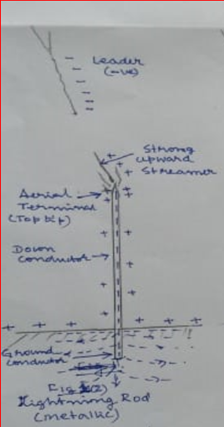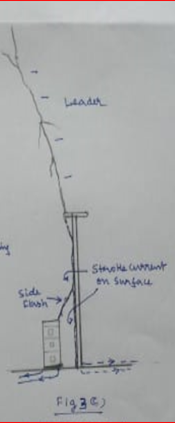Lightning protection in India & Cycle tire LPS.
- Vidyut Surakshit Bharath Abhiyan
- Jul 15, 2020
- 7 min read
Updated: Jun 10, 2023
Lightning Protection Arrangement with a Cycle Tire mounted on a bamboo pole, claimed as per IEC 62305. Does it work?? Can it work??
Note: This blog is published as a warning against the dangers behind using Cycle Tire LPS. BBC also published the same with out any fact checking (LINK BBC NEWS).
Detailed analysis of Cycle tire LPS can be read or downloaded from the link below:
1. Introduction
Recently a new lightning protection arrangement claimed to protect a whole village has been put into use at a few places. But, the main question in our mind was – does it work? Can it work? A brief analysis given below shows that, simply put, “It can not work the way that has been made out. Not only that, it can be dangerous and harmful". Therefore, it is thought fit to explain why it cannot protect against lightning and how it can be harmful.
Fig.1: lightning protection arrangement comprises of a tall wooden pole with a trifurcated to support a circular metallic rim or tube such as the metallic cycle wheel.
The new arrangement is referred to simply as ‘New Arrangement’ throughout this article. It, from its photo, Fig.1, comprises of a tall wooden pole, erected on earth. At the top, the pole has been trifurcated to support a circular metallic rim such as the metallic cycle wheel – without the tire. The nearest comparable conventional arrangement, having decades long proven field experience (individually or in combination with other elements), is the famous Franklin Rod or Lightning Rod (sometimes wrongly termed lightning arrester). In the rest of this article, we will simply refer to this as the lightning rod.
Now we will explain how the lightning rod works effectively and later point-by-point, explain the deficiency of the New Arrangement
2. Functioning of the Lightning Rod
Any proper lightning protection has basically three components: (i) Aerial Terminal/s, (ii) Down conductor/s and (iii) Ground conductor/s. We will discuss this with reference to the simplest case, namely, the Franklin Rod or the Lightning Rod. This is also the closest to the New Arrangement. (This discussion also applies broadly to more elaborate systems).
i. The Air Terminal/s
In the case of a single lightning rod, the top-tip (often pointed) is the Air Terminal. The approaching leader of the (invisible) forward stroke causes development of upward streamers from the Air-terminal. See Fig.2. As the leader approaches closer, the upward streamers develop up further till the two meet (about 20m to 200m above earth) thereby completing the forward stroke. This initiates flow of the very huge lightning currents (in the forward stroke channel) making it a very brilliant channel which is the ‘lightning stroke’ as per common knowledge. This is accompanied by the thunder. Thus the air terminal attracts the lightning stroke to itself thereby preventing the occurrence of stroke to the objects in the vicinity.
ii. The Down Conductor
The down conductor is the portion of the lightning rod from just below the air terminal down to the point of entry into mother earth. This performs two functions. Firstly, the charge required for the development of the upward streamers (from the air terminal) is fed from the induced charges on the earth to the air terminal through this conductor portion. Secondly, the very huge currents (see (i) above) flow to ground from the air terminal down to earth safely through this conductor. Hence the name ‘Down Conductor’.
iii. The Ground Conductor
The down conductor proceeds down into mother-earth by at least 3m to 5m. The huge lightning current flows safely through this portion into surrounding ground (mother earth). See Fig.2. Hence, this portion is known as the Ground Conductor. Thus, the lightning current flows mainly through the bulk ground thereby limiting the surface current component. This current flows over long distances neutralizing the positive charge induced by the negative charge of the cloud. Thus the protection from the lightning rod is achieved.
Fig 2 Lightning Rod (Metallic) Note: only upward streamers from top of rod towards approaching leader (After stroke attachment – stroke current path –dotted line)
3. Functioning of the ‘New Lightning Protection Arrangement’
A metallic rim is mounted at the top of a wooden pole. We are not considering the three leg formation at the top of the pole. However, this formation is quite immaterial. Two possible behaviors of the wooden pole are relevant.
Firstly, the wooden pole is considered to be completely dry and behaves like a good insulator. Under this condition, the metallic rim is electrically a floating body. As the negatively charged downward leader of the forward stroke of lightning approaches, it induces a positive charge on the upper surface of the rim and an equal negative charges on the lower surface. See Fig.3(a). As the leader further approaches (the metallic rim), relatively weak streamers start upwards from the rim. However, the streamers cannot develop as much as in the case of lightning rod since the mother earth cannot supply the required charge through the insulating wooden pole. However, the leader may still terminate on the metallic rim. Almost instantly, one or more of the following can happen:
i. If the dielectric strength of the wooden pole is poor, the leader punctures and proceeds through the inside of the pole to ground. See Fig.3(b). The pole may get blown up and fire and other consequential hazards are possible because of very huge currents that will flow now.
ii. If the dielectric strength of the wooden pole is good, discharges start from the bottom of the rim and go down to earth as a surface discharge along the surface of the wood and reach ground. See Fig. 3(c). Further, as there is no easy path into ground, the current flows substantially in the top layer of the earth. This poses serious hazards of severe injuries (burns) and possibly fatalities to humans (and animals) in the vicinity on the ground.
iii. From the rim, there can be both surface discharge and another discharge through air to a nearby tall object. Obviously, this can also be very hazardous. See Fig. 3(c).
From the above, it is evident that absence of two critical components (compared to conventional lightning rod) namely the down conductor and ground conductor in the New Arrangement can cause serious injuries, fire hazards and even fatalities. Obviously, these are not desirable.
Fig. 3(a)New arrangement: Only top rim (R) metallic. Note – weak upward streamer from one corner and downward
Fig. 3(b) New arrangement: Current of stroke goes in the Interior of the pole (dotted line)
Fig. 3(c) New arrangement: Stroke current will create side flashes & step potentials
4. Limitations of conventional Lightning Rod and extension to New Arrangement
Even in the case of a conventional lightning rod one must keep the following important points:
i. If a person comes into contact with the down conductor, there is the possibility of hazards due to some of the current flowing through the person.
ii. If a person were to stand very close to the down conductor, some part of the ground current can pass through the person and cause injuries/fatality. However, since the ground conductor has gone deep which takes the current also deep the hazards are much less compared to those in the New Arrangement.
iii. If the lightning rod is not very tall, only the objects lying within a semi conical angle of 30 deg, (with the top of the rod being the vertex) will get protected.
Therefore, it is easy to imagine how extremely hazardous it is not have down conductor and ground conductor as in the New Arrangement.
5. Possibility of False conclusions based on limited field data
Based on extensive field data, it is estimated that the number of lightning strokes per year per square km is about 2 to 4. A square km being a large area, unless an object is exceptionally tall, there is no assurance that it will be hit every year. Because of this feature, it is likely that if a ‘New Arrangement’ is set-up somewhere, it may not be hit at all every year. Such an incidence over a limited period of time does not mean that the New Arrangement has avoided occurrence of lightning.
One must be guarded against such fallacious conclusions based on limited data.
6. Overall Conclusions
Considering all the above, it is evident that the ‘New Lightning Protection Arrangement’ cannot be considered as giving even basic protection forgetting protection for a large area like a village. On the other hand, it may result in avoidable injuries (burns etc;) and possibly fatalities over a relatively large area.
Considering the possible hazards to unsuspecting people, it is advisable not to depend on it.
For any doubts/clarifications, please contact:
1. Prof. Dr. G. R. Nagabhushana, (Retd.), BSc (Mysore University), BE, ME, PhD (all from Indian Institute of Science, Bengaluru – 560012)
Brief of Lightning related activities: From 1965, he has been dealing with various aspects of lightning and protection from lightning of: Transmission lines, Satellite Launch Pads (of ISRO), Power equipment & Insulation coordination, 1989- A project was awarded by ADA, Bengaluru for design, fabrication & commissioning of a unique Lightning Test Facility having
a. 4 million volts Impulse (Lightning) Voltage Generator,
b. 200,000 A, 100,000 A, 2000 A and 200A Impulse (lightning) Current Generators
representing the worst lightning stroke, for lightning performance evaluation of Light
Combat Aircraft (LCA) of ADA. This facility was and even now being used under his
guidance to evaluate the lightning performance of Light Combat Aircraft, Hansa
Aircraft, other Aircraft components of HAL (Bengaluru, Hyderabad, Lucknow, etc.)
2. Prof. Dr. Pradipkumar Dixit, BE (Mysore University), M.Tech (KREC, Surathkal (presently NITK)) and PhD from Visvesvaraya Technological University, Belagavi in the area of High Voltage Engineering. Presently, Professor in the department of Electrical & Electronics Engineering, MSRIT, Bengaluru and since May 2013 along with Prof. G R Nagabhushana he has actively involved in the maintenance of 4MV Impulse Voltage Generator, Impulse Current Generators and testing Aircraft components.
3. Er. S. Gopakumar, BE, Program Director Vidyut Surakshit Bharat Abhiyan,
IEC - WG and MT's of TC64: (IEC 60364) Electrical safety standards
WG and MT's ofTC81: (IEC 62305) Lightning Protection
WG's of SC 37 A: (IEC 61643) SPD’s
BIS - ETD 20 (National Electrical Code, IS732, IS3043, IS/IEC 62305), ETD 30 & ETD 50
National Building Code-2016 (electrical committee),
He has published articles about safety in various magazines and published the book, THE MISSING LINK in the subject of electrical safety.






















Dear Mr. Gopakumar,
Thank you for inviting me for today's online seminar on lightning protection.
It was extremely useful for me.
I am Davies and thank you for your time allotted for me for interactions.
I have >35+years of industry hands on experience on electricals with Siemens Ltd. For last 5 years into Electrical Safety Trainings for Siemens & other Customers. Trained >7000+participiants.Officially retired from Siemens on 31/5/2022.
I would like to connect with you & prof.Nagabhushans as per your convenience for some more inputs and interactions.
My Linkedin:https://www.linkedin.com/in/davies-a-r-094892b0
email:davies208@gmail.comemail: davies208@gmail.com
Mobile :9867727022💡